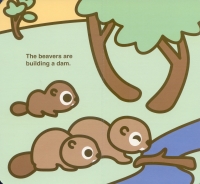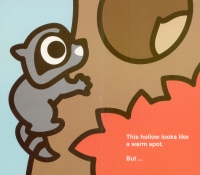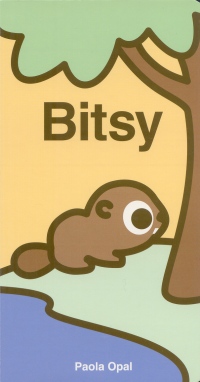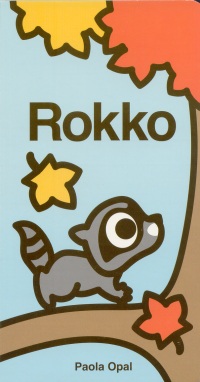| ________________
CM . . .
. Volume XVIII Number 40. . . .June 15, 2012
excerpt:
 In both Bitsy and Rokko, young children can observe young animals engaged in activities where they are beginning to assert their independence from their parents. In Bitsy, the beaver family, consisting of father, mother and their child, Bitsy, are building a dam. When Bitsy sees her/his father cut “down a tree with his big teeth”, Bitsy unsuccessfully attempts to emulate her/his father’s action, but Mother must step in to complete the second tree’s felling. However, when the almost completed dam evidences leakage from a small hole, it is Bitsy who uses her/his small teeth to gnaw down the small tree that is just the right size to plug the small hole. Bitsy’s action leads one of the parents to observe, “Look! The pond is growing bigger – just like you!”
In both Bitsy and Rokko, young children can observe young animals engaged in activities where they are beginning to assert their independence from their parents. In Bitsy, the beaver family, consisting of father, mother and their child, Bitsy, are building a dam. When Bitsy sees her/his father cut “down a tree with his big teeth”, Bitsy unsuccessfully attempts to emulate her/his father’s action, but Mother must step in to complete the second tree’s felling. However, when the almost completed dam evidences leakage from a small hole, it is Bitsy who uses her/his small teeth to gnaw down the small tree that is just the right size to plug the small hole. Bitsy’s action leads one of the parents to observe, “Look! The pond is growing bigger – just like you!”Rokko finds the little raccoon and her/his sister and mother looking for a place to sleep. Rokko decides, “I’m going to find my own place”, but the first site, a hollow in a tree, is already occupied by an owl while a tree branch is too windy. Rokko then locates a hollow log that initially seems nice and warm, but s/he then realizes it’s missing something – her/his mother and sister. However, with the three of them snuggled together in the log, “It’s perfect.”  Of the two books, Bitsy works slightly better than Rokko. In the former, Bitsy is easy to identify as Bitsy is the smallest of the three beavers, but Rokko and her/his sister are the same size, and when both appear together in an illustration, it is difficult to identify which is which. As well, Opal’s use of a circle to visually represent something being hollow is a convention readily understood by adults, but it may be less easily comprehended by Rokko’s intended audience.
Of the two books, Bitsy works slightly better than Rokko. In the former, Bitsy is easy to identify as Bitsy is the smallest of the three beavers, but Rokko and her/his sister are the same size, and when both appear together in an illustration, it is difficult to identify which is which. As well, Opal’s use of a circle to visually represent something being hollow is a convention readily understood by adults, but it may be less easily comprehended by Rokko’s intended audience. As with the other books in the “Simply Small Series”, the simple cartoon-like artwork, with its bold, black outlines, is highly appropriate for the intended target audience. Since Opal never attaches a gender to the little critters, the books are equally accessible to both girls and boys. Both books certainly deserve a place in home and library collections. Recommended. Dave Jenkinson, CM`s editor, lives in Winnipeg, MB.
To comment
on this title or this review, send mail to cm@umanitoba.ca.
Copyright © the Manitoba Library Association. Reproduction for personal
use is permitted only if this copyright notice is maintained. Any
other reproduction is prohibited without permission.
NEXT REVIEW | TABLE OF CONTENTS FOR THIS ISSUE
- June 15, 2012.
AUTHORS | TITLES | MEDIA REVIEWS | PROFILES | BACK ISSUES | SEARCH | CMARCHIVE | HOME |

